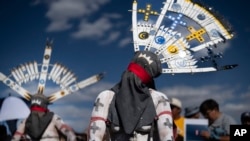ລົດໂຕໂຢຕ້າຄັນສີແດງຂອງທ່ານ ເຟລິກສ ແອສລີ ສົ່ງຂີ້ຝຸ່ນກຸ້ມຂຶ້ນຢູ່ຕາມຄ້ອຍຫີນທີ່ເປັນເນີນຂຶ້ນແລະລົງ ທີ່ລາວໄດ້ໃຊ້ເວລາຫຼາຍຊົ່ວໂມງທຸກໆອາທິດເພື່ອໄປປ້ຳເອົານ້ຳ, ເຊິ່ງແມ່ນຖະໜົນເສັ້ນດຽວກັນທີ່ບັນດາຜູ້ລົງຄະແນນສຽງໃຊ້ ເພື່ອຍ່າງຫຼາຍກິໂລແມັດທຸກໆສີ່ປີ ໄປປ່ອນບັດເລືອກຕັ້ງຂອງເຂົາເຈົ້າໃນການເລືອກຕັ້ງປະທານາທິບໍດີ.
ຢູ່ທີ່ນີ້ໃນເຂດຊົນເຜົ່າພື້ນເມືອງ ນາວາໂຮ ອັນກວ້າງຂວາງທີ່ຖືກລືມ, ເຊິ່ງແມ່ນເຂດສະຫງວນຄົນພື້ນເມືອງທີ່ໃຫຍ່ທີ່ສຸດຢູ່ໃນ ສະຫະລັດ, ຄວາມຍາກລຳບາກແມ່ນໄດ້ແຊກຊຶມເຂົ້າໃນການໃຊ້ຊີວິດປະຈຳວັນ.
ຈຳນວນບ້ານເຮືອນເກືອບ 1 ສ່ວນສາມຄືຂອງທ່ານ ແອສລີ ແມ່ນຍັງບໍ່ມີນ້ຳປະປາໃຊ້. ການບໍ່ມີວຽກເຮັດງານທຳທີ່ສູງຂຶ້ນ ແລະ ຄວາມທຸກຍາກໄດ້ຜັກດັນໃຫ້ຊາວໜຸ່ມ ນາວາໂຮ, ລວມທັງລູກສ່ວນຫຼາຍຂອງທ່ານ ແອສລີ, ຕ້ອງໜີອອກຈາກດິນແດນທີ່ສັກສິດຂອງເຂົາເຈົ້າ ເພື່ອໄປຊອກຫາວຽກເຮັດງານທຳ. ອຸປະສັກດ້ານການຂົນສົ່ງ ແລະ ກົດໝາຍ ແມ່ນໄດ້ຂັດຂວາງປະຊາຊົນພື້ນເມືອງ 420,000 ຂອງລັດອາຣິໂຊນາ ຈາກການໄປລົງຄະແນນສຽງຂອງເຂົາເຈົ້າເປັນເວລາດົນນານ.
ທ່ານ ແອສລີ ອາຍຸ 70 ປີ, ຜູ້ທີ່ສະໜອງການຂັບລົດໄປສົ່ງຜູ້ຂໍຂຶ້ນລົດໄປສະຖານທີ່ເລືອກຕັ້ງໃນວັນເລືອກຕັ້ງກ່າວວ່າ “ປະຊາຊົນໄດ້ສູນເສຍຄວາມເຊື່ອຖືໃນລັດຖະບານ ແລະ ເຂົາເຈົ້າບໍ່, ເຈົ້າບໍ່ສົນໃຈທີ່ຈະລົງຄະແນນສຽງອີກແລ້ວ. ປະຊາຊົນບໍ່ໄດ້ຮັບສິ່ງທີ່ເຂົາເຈົ້າຖືກສັນຍາໄວ້.”
ແຕ່ວ່າມັນແມ່ນຜູ້ລົງຄະແນນສຽງພື້ນເມືອງຄືລາວ ຜູ້ທີ່ອາດເປັນກະແຈສຳຄັນທີ່ຈະຊະນະໃນລັດ ອາຣິໂຊນາ ແລະ ບາງລັດທີ່ມີການໂອນອຽງດ້ານການແຂ່ງຂັນຫຼາຍທີ່ສຸດໃນເດືອນພະຈິກນີ້. ໃນປີ 2020, ລັດ ອາຣິໂຊນາ ໄດ້ລົງຄະແນນສຽງໃຫ້ປະທານາທິບໍດີສັງກັດພັກເດໂມແຄຣັດເປັນຄັ້ງທຳອິດໃນຮອບຫຼາຍທົດສະວັດ, ໂດຍປະທານາທິບໍດີ ໂຈ ໄບເດັນ ໄດ້ຊະນະການແຂ່ງຂັນດ້ວຍປະມານ 10,500 ຄະແນນສຽງ.
ຊາວອາເມຣິກັນພື້ນເມືອງ, ຜູ້ທີ່ປະກອບເປັນ 5.2 ເປີເຊັນຂອງປະຊາກອນໃນລັດ ອາຣິໂຊນາ, ໄດ້ເຫັນປະຊາຊົນອອກມາປ່ອນບັດຫຼາຍຂຶ້ນ, ລົງຄະແນນສຽງຈຳນວນຫຼວງຫຼາຍໃຫ້ພັກເດໂມແຄຣັດ, ອີງຕາມການວິເຄາະຂໍ້ມູນໂດຍອົງການຂ່າວ ເອພີ.
ໄຊຊະນະດັ່ງກ່າວໄດ້ດຶງດູດຄວາມສົນໃຈຂອງບັນດານັກການເມືອງຈາກທັງສອງພັກ, ຜູ້ທີ່ຕອນນີ້ໄດ້ພາກກັນຫຼັ່ງໄຫຼໄປຫາບາງເຂດທີ່ຊົນນະບົດທີ່ສຸດຂອງລັດ ອາຣິໂຊນາ ໃນຂະນະທີ່ເຂົາເຈົ້າພະຍາຍາມຈະປິດຊ່ອງຫວ່າງນ້ອຍໆນັ້ນ. ພັກເດໂມແຄຣັດ ຫວັງວ່າຈະຢ້ຳໄຊຊະນະດັ່ງກ່າວ, ໃນຂະນະທີ່ພັກຣີພັບບລີກັນເຫັນໂອກາດທີ່ຈະໃຊ້ຄວາມອຶດອັດໃຈຂອງບັນດາຜູ້ລົງຄະແນນສຽງພື້ນເມືອງກັບເສດຖະກິດດັ່ງກັບໂອກາດທີ່ຈະກວາດເອົາຄະແນນສຽງໃໝ່.
ອ່ານຂ່າວນີ້ເປັນພາສາອັງກິດ
Felix Ashley’s red Toyota sends a plume of dust billowing along the sloping hills and boulders he traverses hours every week to pump water – the same roadway voters walk miles every four years to cast their ballots in presidential elections.
Here on this forgotten swath of the Navajo Nation, the largest Native American reservation in the United States, hardship is embedded into day-to-day life.
Nearly a third of homes like Ashley’s still don’t have running water. Soaring unemployment and poverty has pushed young Navajos, including most of Ashley’s children, to leave their sacred lands in search of jobs. Logistical and legal obstacles have long stood in the way of Arizona’s 420,000 Native citizens casting their vote.
“People lose trust in the government and they don’t – you don’t – care to vote anymore. People don’t get what they were promised,” said 70-year-old Ashley, whose family offers rides to hitchhikers to polls on Election Day.
Yet it is Native voters like him who could be key to winning Arizona and some of the most contested swing states in November. In 2020, Arizona voted for a Democratic president for the first time in decades, with President Joe Biden winning the race by around 10,500 votes.
Native Americans – who make up 5.2% of Arizona– saw a surge in turnout, voting in large numbers for the Democratic Party, according to a data analysis by the Associated Press.
The victory turned the heads of politicians from both parties, who now flock to some of the most remote swaths of Arizona as they try to close razor thin margins. Democrats are hoping to repeat the feat, while Republicans see an opportunity to use Native voters’ frustration with the economy as a chance to sweep up new votes.






ຟໍຣັມສະແດງຄວາມຄິດເຫັນ